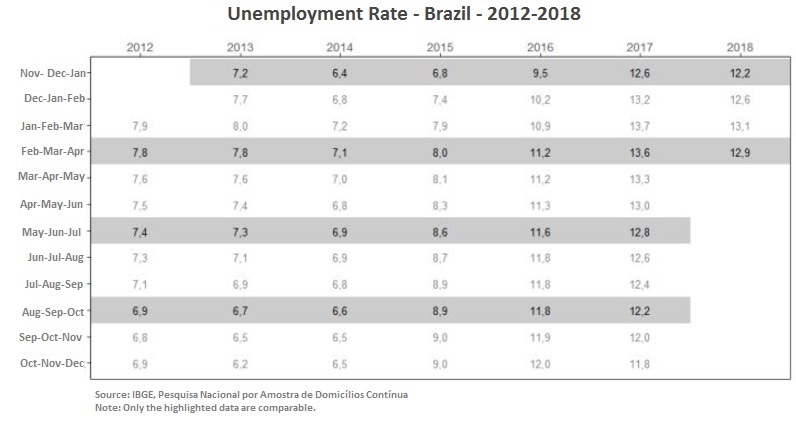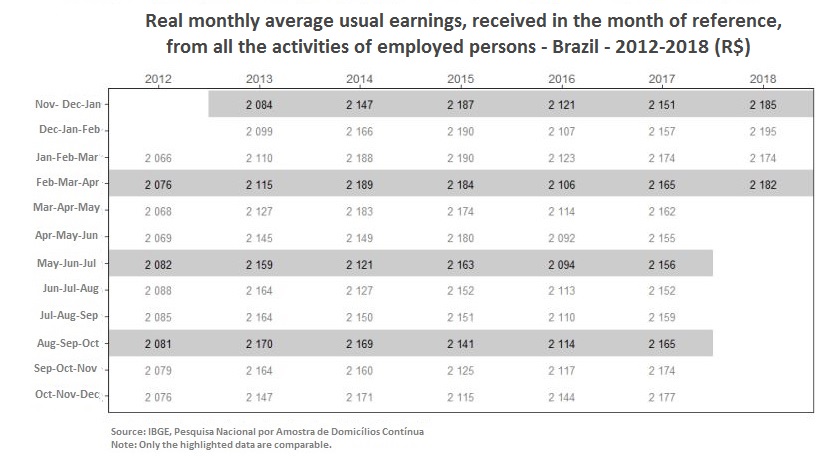Continuous PNAD: unemployment rate of 12.9% in the quarter ended April
May 29, 2018 09h00 AM | Last Updated: May 29, 2018 04h24 PM
The unemployment rate (12.9%) in the quarterly moving average between February to April 2018 increased by 0.7 percentage points against the quarter November 2017 to January 2018 (12.2%). In comparison with the same moving quarter as in the previous year, from February to April 2017 (13.6%), there was decrease of 0.7 percentage points.
| Indicator / Period | Feb-Mar-Apr 2018 | Nov/17-Dec/17-Jan/18 | Feb-Mar-Apr 2017 |
|---|---|---|---|
| Unemployment rate | 12.9% | 12.2% | 13.6% |
| Usual real earnings | R$ 2.182 | R$ 2,185 | R$ 2,165 |
| Change of the usual real earnings in relation to: | -0.2 (stable) | 0.8 (stable) | |
The unemployment population (13.4 million) increased 5.7% against the previous quarter (12.7 million). In comparison with the same quarter a year ago, when there were 14 milliom unemploye, there was decrease of 4.5%.
The employment population (90.7 million) in the quarter February to April 2018 fell by 1.1% in relation to the quarter November 2017 to January 2018. In comparison with the same quarter a year ago (February to April 2017), when there were 89.2 million employed persons, there was increase of 1.7%.
So, the employment-population ratio (53.6%) fell by 0.6 percentage points against the previous quarter (54.2%). In comparison with the same quarter a in 2017, when the employment-population ratio was 53.2%, with increase of 0.4 p.p.
The number of workers with a formal employment contract (32.7 million) fell by 1.7% in comparison with the previous quarter (November 2017 to January 2018), a decrease of 567 thousand persons. In comparison with the quarter between February to April 2017,there was decrease of -1.7% (-557 thousand persons).
The number of workers without a formal employment contract (10.9 million persons) remained stable in relation to the previous quarter. Against the same quarter in 2017, it increased by 6.3% (by 647 thousand persons).
The category of self-employed workers (23.0 million persons) remained stable in comparison with the quarter between November 2017 and January 2018. Against the same period in the previous year, there was increase of 3.4% (747 thousand persons).
The average usual real earnings (R$ 2,182) of the quarter February to April 2018 was stable in comparison with the previous quarter (R$ 2,185), as in relation to the same quarter in the previous year (R$ 2,165).
The average real earnings (R$ 193 billion) was stable when in comparison with the quarterly moving average of November 2017 to January 2018 in comparison with the same quarter a year ago.
The complete publication, the summary chart and the presentation of the monthly Continuous PNAD are on the right of this page.
The unemployment rate was estimated at 12.9% in the moving quarter of February to April 2018, with an increase of 0.7 percentage points against the previous moving quarter (12.2%). Against the same moving quarter in February to April 2017 (13.6%), there was decrease (-0.7 percentage points).
In the quarter February to April 2018, there were approximately 13.4 million unemployed persons in Brazil. That contingent increased 5.7% (723 thousand persons) against the same quarter as in November 2017 to January 2018, when unemployment was estimated at 12.7 million persons. Against the same quarter a year ago (14.0 million), that estimate fell 4.5% (with a reduction by 645 thousand unemployed persons).

The number of employed persons was estimated at 90.7 million in the quarter February to April 2018. That contingent fell by 1.1% in relation to the previous quarter (by 969 thousand persons). In relation to the same quarter in 2017, when there were 89.2 million employed persons in Brazil, that indicator increased 1.7% (by more than 1.495 million persons).
The employment population ratio (percentage of employed persons in the population at working age) was estimated at 53.6% in the quarter February to April 2018, having fallen by 0.6 percentage points in comparison with the quarter November 2017 to January 2018 (54.2%). Against the same quarter a year ago, when the employment population ratio in Brazil was 53.2%, that indicator fell by 0.4 percentage points.
Workforce (employed and unemployed persons), in the quarter February to April 2018 was estimated at 104.1 million persons. This population remained stable versus that in the quarter November 2017 to January 2018. Versus the same quarter a year ago, there was expansion of 0.8% (860 thousand persons more).
The contingent of persons out of the workforce, in the quarter February to April 2018, was estimated at 65.2 million persons. That number increased 0.7% in comparison with that in the previous quarter (427 thousand persons more). In comparison with the same quarter in the previous year, there was increase by 1.2% (756 thousand persons more).
The contingent of employed persons with a formal contract in the private sector (except domestic workers), estimated at 32.7 million persons fell by 1.7% (567 thousand persons) against the previous quarter (November 2017 to January 2018). In relation to the same quarter in 2017, there was also decrease: -1.7% (-557 thousand persons).
From February to April 2018, the number of workers without a formal contract in the private sector (10.9 million persons) recorded stability in relation to the previous quarter. Against the same quarter a year ago, there was increase of 6.3% (647 thousand persons more).
The contingent of self-employed workers (23.0 million) was stable in comparison with the same quarter a year ago (November 2017 to January 2018). Against the same period a year ago, that figure increased 3.4% (747 thousand persons more).
The number of employers (4.4 million persons) was stable in relation to that in the previous quarter. Against the same quarter in 2017, it increased 5.7% (236 thousand persons more).
The category of domestic workers (6.2 million persons) fell by 2.5% in the comparison with the quarter November to January 2018. Versus the quarter February to April 2017, there was stability.
Workers employed in the public sector (including military and civil servants), estimated at 11.4 million persons, recorded stability against the previous quarter. Against the same quarter a year ago, this group recorded decrease of 3.3% (359 thousand persons more).
The analysis of employed persons by groups of activity, in the moving quarter February to April 2018, versus that between November 2017 to January 2018, showed there was no increase in this category. There was decrease in the following groups: Construction (2.7%, or 186 thousand persons less), Trade, repair of motor vehicles and motorcycles (2.5%, or 439 persons less) and Domestic services (2.7%, or 172 thousand persons less).
Against the quarter February to April 2017, there was increase in the following categories: Public administration, defense, social security, education, human health and social services (3.8% or 569 thousand persons more) and Other services (9.1%, or 389 persons more). There was decrease in the group Agriculture, livestock, forestry, fishing and aquiculture (3.0% or 259 thousand persons more).

The average real earnings from all the activities of employed persons (R$ 2,182) in the quarter February to April 2018 was stable both against the previous quarter (R$ 2,185), and in relation to the same quarter a year ago (R$ 2.165)
Considering the groups of activity, in the moving quarter February to April 2018, against the quarter November 2017 to January 2018, only the category Domestic Services recorded increase (2.2%, or R$ 19 more). The other groups did not record any significant change. In comparison with the quarter February to April 2017, there was increase in the category Public administration, defense, social security, education, human health and social services (3.2%, or R$ 100 more). No relevant changes were observed in the remaining groups.
The average real earnings from all the activities of employed persons was estimated, for the moving quarter February 2018 to April 2018, at R$ 193 billion reais. The figure remained stable in both comparisons.

